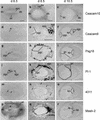Carcinoembryonic antigen-related cell adhesion molecule 10 expressed specifically early in pregnancy in the decidua is dispensable for normal murine development
- PMID: 12482980
- PMCID: PMC140660
- DOI: 10.1128/MCB.23.1.272-279.2003
Carcinoembryonic antigen-related cell adhesion molecule 10 expressed specifically early in pregnancy in the decidua is dispensable for normal murine development
Abstract
The carcinoembryonic antigen (CEA) family consists of a large group of evolutionarily and structurally divergent glycoproteins. The murine CEACAM9 and CEACAM11-related proteins as well as the pregnancy-specific glycoproteins (PSG) are secreted members of the CEA family which are differentially expressed in fetal trophoblast cell populations during placental development. PSG are essential for a successful pregnancy, possibly by protecting the semiallotypic fetus from the maternal immune system. In contrast, Ceacam10 mRNA, coding for a protein identical in structure with CEACAM11-related proteins, is expressed in the maternal decidua surrounding the implantation site of the conceptus only during early stages of gestation between day 6.5 and day 10.5 postcoitum. To determine its role during murine development, we inactivated Ceacam10. Ceacam10(-/-) mice developed, like the previously established Ceacam9(-/-) mice, indistinguishably from wild-type littermates with respect to sex ratio, weight gain, and fertility. However, a small but significant reduction of the litter size by 23% was observed in Ceacam10(-/-) matings. Furthermore, combining the Ceacam9 and Ceacam10 null alleles, both located on chromosome 7, by meiotic recombination and subsequent mating of heterozygotes carrying both knockout alleles on one chromosome yielded wild-type and double knockout offspring at the expected Mendelian ratio. Taken together, both Ceacam10 and Ceacam9, alone or in combination, are not essential for either murine placental and embryonic development or for adult life.
Figures



Similar articles
-
Trophoblast cell-specific carcinoembryonic antigen cell adhesion molecule 9 is not required for placental development or a positive outcome of allotypic pregnancies.Mol Cell Biol. 2000 Oct;20(19):7140-5. doi: 10.1128/MCB.20.19.7140-7145.2000. Mol Cell Biol. 2000. PMID: 10982830 Free PMC article.
-
Fertility impairment in granulocyte-macrophage colony-stimulating factor-deficient mice.Biol Reprod. 1999 Feb;60(2):251-61. doi: 10.1095/biolreprod60.2.251. Biol Reprod. 1999. PMID: 9915988
-
Two waves of evolution in the rodent pregnancy-specific glycoprotein (Psg) gene family lead to structurally diverse PSGs.BMC Genomics. 2023 Aug 21;24(1):468. doi: 10.1186/s12864-023-09560-6. BMC Genomics. 2023. PMID: 37605167 Free PMC article.
-
The role of corticotropin-releasing hormone in blastocyst implantation and early fetal immunotolerance.Horm Metab Res. 2007 Jun;39(6):474-7. doi: 10.1055/s-2007-980190. Horm Metab Res. 2007. PMID: 17578767 Review.
-
Implantation: embryonic signals and the modulation of the uterine environment--a review.Placenta. 2004 Apr;25 Suppl A:S26-31. doi: 10.1016/j.placenta.2004.01.014. Placenta. 2004. PMID: 15033303 Review.
Cited by
-
Conservation at the uterine-placental interface.Proc Natl Acad Sci U S A. 2022 Oct 11;119(41):e2210633119. doi: 10.1073/pnas.2210633119. Epub 2022 Oct 3. Proc Natl Acad Sci U S A. 2022. PMID: 36191208 Free PMC article.
-
Increased osteoclastogenesis in mice lacking the carcinoembryonic antigen-related cell adhesion molecule 1.PLoS One. 2014 Dec 9;9(12):e114360. doi: 10.1371/journal.pone.0114360. eCollection 2014. PLoS One. 2014. PMID: 25490771 Free PMC article.
-
Maternal oxycodone treatment causes pathophysiological changes in the mouse placenta.Placenta. 2020 Oct;100:96-110. doi: 10.1016/j.placenta.2020.08.006. Epub 2020 Aug 23. Placenta. 2020. PMID: 32891007 Free PMC article.
-
Genetic analysis of litter size in mice.J Vet Med Sci. 2015 Mar;77(3):353-8. doi: 10.1292/jvms.14-0350. Epub 2014 Nov 26. J Vet Med Sci. 2015. PMID: 25428703 Free PMC article.
-
Structure and evolution of the mouse pregnancy-specific glycoprotein (Psg) gene locus.BMC Genomics. 2005 Jan 12;6:4. doi: 10.1186/1471-2164-6-4. BMC Genomics. 2005. PMID: 15647114 Free PMC article.
References
-
- Beauchemin, N., P. Draber, G. Dveksler, P. Gold, S. Gray-Owen, F. Grunert, S. Hammarström, K. V. Holmes, A. Karlsson, M. Kuroki, S. H. Lin, L. Lucka, S. M. Najjar, M. Neumaier, B. (tm)brink, J. E. Shively, K. M. Skubitz, C. P. Stanners, P. Thomas, J. A. Thompson, M. Virji, S. von Kleist, C. Wagener, S. Watt, and W. Zimmermann. 1999. Redefined nomenclature for members of the carcinoembryonic antigen family. Exp. Cell Res. 252:243-249. - PubMed
-
- Bohn, H., and E. Weinmann. 1974. Immunological disruption of implantation in monkeys with antibodies to human pregnancy specific beta 1-glycoprotein (SP1). Arch. Gynäkol. 217:209-218. (Author's translation.) - PubMed
-
- Boulton, I. C., and S. D. Gray-Owen. 2002. Neisserial binding to CEACAM1 arrests the activation and proliferation of CD4+ T lymphocytes. Nat. Immunol. 3:229-236. - PubMed
-
- Chen, T., W. Zimmermann, J. Parker, I. Chen, A. Maeda, and S. Bolland. 2001. Biliary glycoprotein (BGPa, CD66a, CEACAM1) mediates inhibitory signals. J. Leukoc. Biol. 70:335-340. - PubMed
Publication types
MeSH terms
Substances
LinkOut - more resources
Full Text Sources
Molecular Biology Databases
